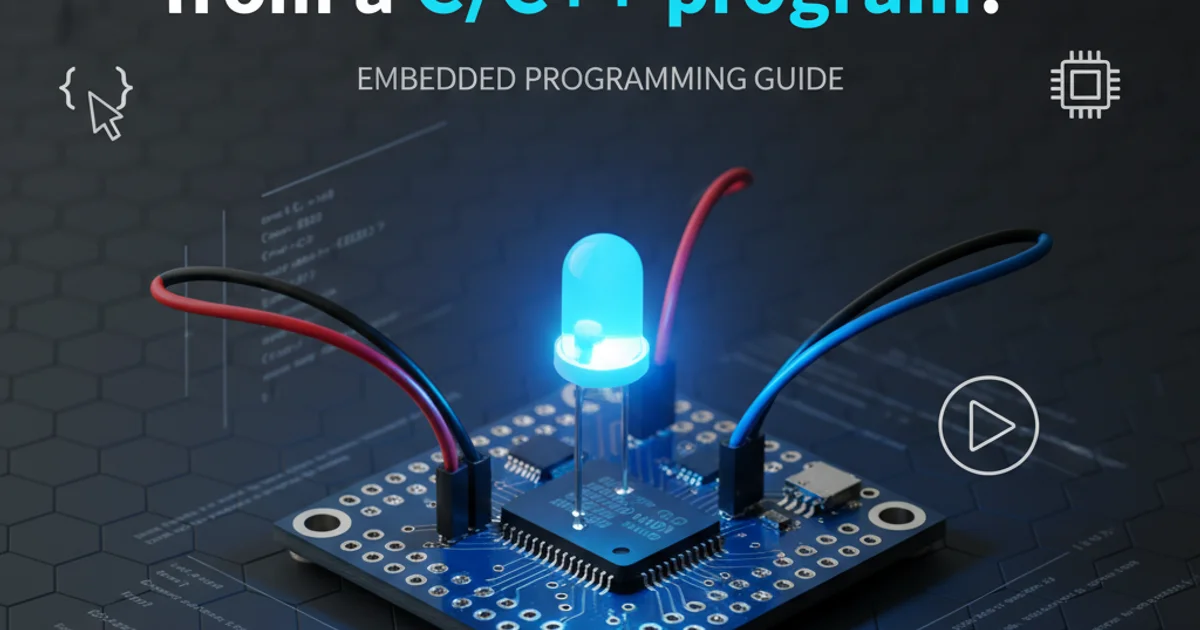Steps to make a LED blink from a C/C++ program?
Categories:
Making an LED Blink with C/C++: A Step-by-Step Guide

Learn the fundamental principles and practical steps to control an LED using C/C++ programming, covering both microcontroller and PC-based approaches.
Blinking an LED is often the 'Hello World' of embedded systems and physical computing. It's a simple yet powerful way to confirm your development environment is set up correctly and that you can interact with hardware using code. This article will guide you through the process, explaining the core concepts and providing practical examples for common scenarios, from microcontrollers to basic PC control.
Understanding the Basics: Hardware and Software Interaction
To make an LED blink, you need to understand the interplay between your software (C/C++ code) and the hardware (the LED and the device controlling it). At its core, blinking an LED involves toggling a digital output pin between a HIGH (ON) and LOW (OFF) state, with a delay in between. The specific method depends heavily on the hardware platform you are using.
flowchart TD
A[Start Program] --> B{Initialize GPIO Pin};
B --> C{Set Pin HIGH (LED ON)};
C --> D[Wait for Delay];
D --> E{Set Pin LOW (LED OFF)};
E --> F[Wait for Delay];
F --> C;Basic LED Blinking Logic Flow
Microcontroller-Based LED Blinking (e.g., Arduino, ESP32)
Microcontrollers are the most common platforms for directly controlling LEDs. They provide General Purpose Input/Output (GPIO) pins that can be configured as outputs. The C/C++ code running on the microcontroller directly manipulates these registers to change the pin's voltage level. We'll use Arduino-like syntax for simplicity, as it's widely understood and based on C++.
const int ledPin = 13; // The pin the LED is connected to
void setup() {
pinMode(ledPin, OUTPUT); // Configure the pin as an output
}
void loop() {
digitalWrite(ledPin, HIGH); // Turn the LED on
delay(1000); // Wait for a second
digitalWrite(ledPin, LOW); // Turn the LED off
delay(1000); // Wait for a second
}
PC-Based LED Control (e.g., Raspberry Pi, USB-to-GPIO)
While less common for direct LED control than microcontrollers, you can also blink an LED from a C/C++ program running on a PC, especially if that PC has accessible GPIO pins (like a Raspberry Pi) or is connected to an external USB-to-GPIO adapter. On Linux systems, this often involves interacting with the /sys/class/gpio interface or using specific libraries.
#include <stdio.h>
#include <stdlib.h>
#include <string.h>
#include <unistd.h>
#include <fcntl.h>
#define GPIO_PIN "4" // Example: GPIO pin 4 on Raspberry Pi
void write_gpio(const char *path, const char *value) {
int fd = open(path, O_WRONLY);
if (fd == -1) {
perror("Error opening file");
exit(1);
}
if (write(fd, value, strlen(value)) == -1) {
perror("Error writing to file");
exit(1);
}
close(fd);
}
int main() {
// Export the GPIO pin
write_gpio("/sys/class/gpio/export", GPIO_PIN);
usleep(100000); // Give time for export to complete
// Set pin direction to output
char direction_path[50];
sprintf(direction_path, "/sys/class/gpio/gpio%s/direction", GPIO_PIN);
write_gpio(direction_path, "out");
// Get value file path
char value_path[50];
sprintf(value_path, "/sys/class/gpio/gpio%s/value", GPIO_PIN);
for (int i = 0; i < 10; i++) { // Blink 10 times
write_gpio(value_path, "1"); // Turn LED ON
printf("LED ON\n");
usleep(500000); // 0.5 second delay
write_gpio(value_path, "0"); // Turn LED OFF
printf("LED OFF\n");
usleep(500000); // 0.5 second delay
}
// Unexport the GPIO pin
write_gpio("/sys/class/gpio/unexport", GPIO_PIN);
return 0;
}
/sys/class/gpio requires root privileges. For more robust and safer PC-based GPIO control, consider using libraries like libgpiod or specific vendor SDKs (e.g., WiringPi for Raspberry Pi, though it's deprecated).Compiling and Running Your Code
The compilation and deployment process varies significantly between platforms:
- Microcontrollers (e.g., Arduino IDE): The IDE handles compilation (using
avr-gccor similar toolchains) and flashing the compiled binary to the board. You simply click 'Upload'. - Raspberry Pi (Linux): You'll typically use
gccorg++from the command line.Thegcc -o led_blink led_blink.c sudo ./led_blinksudois necessary for GPIO access. - Other Embedded Systems: You'll use a cross-compilation toolchain specific to your target architecture and a flashing utility to deploy the firmware.
1. Choose Your Platform
Decide whether you're using a microcontroller (like Arduino) or a single-board computer (like Raspberry Pi) for your project.
2. Wire the LED Circuit
Connect your LED to a digital output pin on your chosen board, ensuring you include a current-limiting resistor in series. Connect the other end of the resistor to the LED's anode (longer leg) and the LED's cathode (shorter leg) to ground.
3. Write the C/C++ Code
Implement the blinking logic using the appropriate API for your platform (e.g., digitalWrite for Arduino, or file I/O for Linux GPIO).
4. Compile and Upload/Run
Compile your code. For microcontrollers, upload it using the IDE. For Linux-based systems, compile with gcc and run the executable, typically with sudo.
5. Observe the Blink
Watch your LED blink! If it doesn't, double-check your wiring, resistor value, pin number, and code logic.